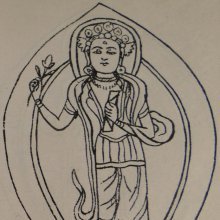Vajrakhanda, Vajrakhaṇḍa, Vajra-khanda: 1 definition
Introduction:
Vajrakhanda means something in Buddhism, Pali, Hinduism, Sanskrit. If you want to know the exact meaning, history, etymology or English translation of this term then check out the descriptions on this page. Add your comment or reference to a book if you want to contribute to this summary article.
Images (photo gallery)
In Hinduism
Vastushastra (architecture)
Source: OpenEdition books: Architectural terms contained in Ajitāgama and RauravāgamaVajrakhaṇḍa (वज्रखण्ड) refers to “n. of a type of pillar § 3.22.”.—(For paragraphs cf. Les enseignements architecturaux de l'Ajitāgama et du Rauravāgama by Bruno Dagens)

Vastushastra (वास्तुशास्त्र, vāstuśāstra) refers to the ancient Indian science (shastra) of architecture (vastu), dealing with topics such architecture, sculpture, town-building, fort building and various other constructions. Vastu also deals with the philosophy of the architectural relation with the cosmic universe.
In Buddhism
Tibetan Buddhism (Vajrayana or tantric Buddhism)
Source: archive.org: The Indian Buddhist IconographyVajrakhaṇḍa (वज्रखण्ड) or Vajrakhaṇḍalokeśvara refers to number 78 of the 108 forms of Avalokiteśvara found in the Machhandar Vahal (Kathmanu, Nepal). [Machhandar or Machandar is another name for for Matsyendra.].
Accordingly,—
“Vajrakhaṇḍa also is similar to [Piṇḍapātra Lokeśvara] in all respects, except that here the god holds the lotus bud in his right hand and the book against his chest with the left.—Piṇḍapātra Lokeśvara is one-faced and two-armed and stands on a lotus. He holds the Piṇḍapātra (the bowl) in his two hands near the navel”.
The names of the 108 deities [viz., Vajrakhaṇḍa] possbily originate from a Tantra included in the Kagyur which is named “the 108 names of Avalokiteshvara”, however it is not yet certain that this is the source for the Nepali descriptions. Tibetan Buddhism includes schools such as Nyingma, Kadampa, Kagyu and Gelug. Their primary canon of literature is divided in two broad categories: The Kangyur, which consists of Buddha’s words, and the Tengyur, which includes commentaries from various sources. Esotericism and tantra techniques (vajrayāna) are collected indepently.
See also (Relevant definitions)
Partial matches: Vajra, Khanda.
Starts with: Vajrakhandalokeshvara.
Full-text: Vajrakhandalokeshvara.
Relevant text
Search found 2 books and stories containing Vajrakhanda, Vajrakhaṇḍa, Vajra-khanda, Vajra-khaṇḍa; (plurals include: Vajrakhandas, Vajrakhaṇḍas, khandas, khaṇḍas). You can also click to the full overview containing English textual excerpts. Below are direct links for the most relevant articles:
The Indian Buddhist Iconography (by Benoytosh Bhattachacharyya)
Kautilya Arthashastra (by R. Shamasastry)
Chapter 13 - Superintendent of Gold in the Goldsmiths’ Office < [Book 2 - The duties of Government Superintendents]
